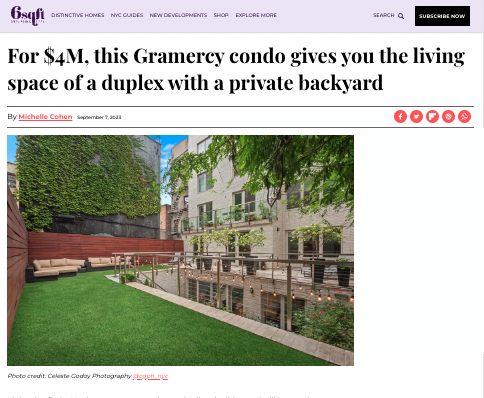12 Places to Watch 4th of July Fireworks in NYC
Image courtesy of Backal Hospitality Group
To most Americans, the Fourth of July means good food, drinks, time spent with family and friends, but most importantly, fireworks. Luckily for New Yorkers, the city has plenty of opportunities to see fireworks with Macy’s annual 4th of July Fireworks show and Jersey City’s own grand fireworks display. For those seeking an unforgettable Independence Day experience, here is a selection of the best ticketed events to enjoy this year’s July 4th fireworks celebration, from waterfront bars lining the East River’s piers to the city’s highest observation decks.
Circle Line July 4th Fireworks Cruise
Pier 83, Manhattan
For the summer season, Circle Line has included a special 4th of July cruise experience. The full experience spans five hours of cruising down the Hudson River and taking in incredible views of NYC before the firework show begins later that night. Early bird tickets start at $229 for adults and $179 for children under 12. Ticket purchases include access to a buffet with summer favorites like hamburgers, hot dogs, fried chicken, mac n’ cheese, and more.
4th of July Cruise New York Waterway
Departs from Port Imperial, Weehawken
NY Waterway is offering guests the opportunity to view July 4th’s fireworks spectacle over the East River from the water. As the boat sails down the Hudson River and around the southern tip of Manhattan, guests will have views of the Statue of Liberty, World Trade Center, and other iconic NYC landmarks. Participants from NYC will receive a voucher for a free ferry ride from Midtown to Port Imperial, where they will then board the July 4th cruise boat. Tickets are priced at $170 for adults, $160 for seniors, and $130 for children ages 4 to 12. Children under the age of 3 can get on for free.
Brooklyn Grange
850 Third Avenue, Sunset Park
Watch the fireworks from the rooftop of Sunset Park’s Brooklyn Grange, with breathtaking views of the show over the East River and New Jersey’s Liberty State Park firework show in the distance. Included with tickets are a wide variety of eats, all-you-can-drink beer and wine, specialty cocktails, live music, tarot card readings, and more. General admission tickets cost $165 each.
Edge at Hudson Yards
30 Hudson Yards, Hudson Yards
The Edge is offering an unparalleled 4th of July experience atop its 1,100-foot-high sky deck, the highest of its kind in NYC. From 7 p.m. to midnight, guests can take in the surrounding city skyline and watch the sky light up at 9 p.m. as the fireworks shows commence. Included with each ticket are two glasses of champagne, or non-alcoholic drinks for guests under 21, as well as a gourmet corn dog and unlimited popcorn. There will also be a live DJ performance to add a soundtrack to the memorable experience.
For those looking for more thrill, the Edge is offering a 4th of July Climb up the building’s peak, the highest open-air building ascent in the world, known as City Climb. For $185 per person, guests will begin their climb at 7:45 p.m. before scaling the ascent and enjoying the fireworks from 1,200 feet at 9 p.m. Tickets to both exclusive events can be purchased here, with the experience from the Edge costing $250 per person and the City Climb experience costing $185 per person.
July 4th Firework Show & Celebration at Riverpark
Riverpark, 450 East 29th Street, Manhattan
Featuring live music, specialty BBQ, and panoramic views of the East River, Backal Hospitality Group’s 4th of July celebration at Riverpark is one of the most exciting locations to spend Independence Day this year. The celebration will feature a selection of specialty BBQ food, including pulled pork sandwiches, ribs, burgers, and much more. General admission tickets start at $250, which includes the open beer, wine, and food stations. VIP packages cost $325 and include the open bar, as well as liquor and champagne for the fireworks show. The VIP package also includes railing access for the best view of the fireworks. Tickets can be purchased here.
Magic Hour Rooftop Bar & Lounge at Moxy Times Square
485 Fashion Avenue, Manhattan
The largest indoor and outdoor all-season hotel rooftop is opening up its space for an unforgettable July 4th fireworks celebration. The rooftop offers guests incredible views of the Empire State Building and city skyline, with views of the fireworks spectacle over the East River. For $160, guests can purchase the Red, White & Views 4th of July package, which includes a reserved table for four guests, three small plates of your choice, a dessert platter, and a bucket of six beers. Tickets can be purchased here.
Jersey City’s 50 Star Fireworks
Exchange Place Plaza, Jersey City
Enjoy one of the largest fireworks displays in the country from Jersey City’s waterfront this July 4th. Food and drink will be available for purchase from a variety of vendors from the Jersey City Midnight Market. 50 Star Fireworks is one of the most renowned fireworks companies in the nation, having created displays for presidential inaugurations and the Olympics. The event will start at 12 p.m. and last until 10 p.m.
GOSPËL Tribe and The William Vale Independence Day Celebration
111 North 12th Street, Williamsburg
Williamsburg’s luxury hotel, The William Vale, is teaming up with popular nightspot the GOSPËL Tribe to create an exciting Independence Day experience. The fireworks celebration will span across the hotel’s top two floors, with seating being distributed on a first-come, first-serve basis. Tickets for entry between 6 p.m. and 7 p.m. cost $180, and tickets for entry between 7 p.m. and 8 p.m. cost $220. If you don’t want to rush yourself, tickets for entry at any time cost $250.
The Rockaway Hotel + Spa’s 4th of July Celebration
108-10 Rockaway Beach Drive, Rockaway
The Rockaway Hotel + Spa is hosting its own picnic-themed 4th of July celebration this year on The Rooftop, a 6,000-square-foot indoor and outdoor space with panoramic views of Jamaica Bay, the Atlantic Ocean, and the Manhattan skyline. Ticket purchases include food, beer, and wine for two hours. Admission costs $25 for kids and $55 for adults and can be purchased here.
Industry Kitchen
70 South Street at Maiden Lane, Manhattan
Located right next to the East River, Industry Kitchen’s 4th of July celebration offers guests an unparalleled location to view the fireworks show. Industry Kitchen’s chef, Jonathan Haffmans, has created a special menu for Independence Day that includes jumbo shrimp cocktails, braised beef short rib sliders, and farm stand fresh watermelon, in addition to their menu favorites. Walk-ins for the event are welcome, but reservations are encouraged.
Watermark
Pier 15, 78 South Street, Manhattan
Featuring unobstructed views of the Brooklyn skyline and fireworks celebration, Watermark’s waterfront location is an ideal location to spend your July 4th. Food and drink options include fresh, off-the-grill bites, endless rosé, tropical cocktails, and frozen drinks. A rotating lineup of DJs will also be performing throughout the full-day celebration. General admission tickets cost $20 per person for the 12 p.m. to 5 p.m. daytime session, with separate tickets for the 6 p.m. to 12 a.m. session. Private VIP tables and cabanas are also able for reservation.
4th of July at SUMMIT One Vanderbilt
45 E 42nd Street, Manhattan
One of the highest observation decks in NYC is hosting its own Independence Day celebration. Come enjoy food provided by renowned NYC BBQ restaurant Blue Smoke, a premium open bar, and the fireworks spectacle, at over 1,000 feet in the air. Tickets cost $300 for the public and can be purchased here.
12 spots to watch the 4th of July fireworks in NYC
POSTED TODAY, JUNE 27, 2022BY AARON GINSBURG
Image courtesy of Circle Line
Image courtesy of Backal Hospitality Group
All The Information On NYC Pride March 2021
Though it still won’t be entirely back to normal, the NYC Pride March is back for a mostly virtual event on Sunday, June 27th. “The Fight Continues” is the 2021 theme, and there will be many advocates from the LGBTQIA+ community participating in the March and other events. In addition, there will be celebratory performances and fun activities. Ahead, we’ve condensed all the info you need to know about NYC Pride and highlighted a few other great events.
THE THEME
NYC Pride’s 2021 theme is “The Fight Continues.” As the organization explains: “With the coronavirus pandemic still ongoing, issues of police brutality, the alarming murder rate for trans POC, economic hardship, climate disasters, violent efforts to disenfranchise voters, our rights as a community being questioned at the level of the Supreme Court, and more, we are in the midst of many different fights.”
THE MARCH
The famous Pride March will take place on Sunday, June 27. For the fifth consecutive year, there will be a live broadcast on ABC-7 from 12-3pm. (You can also watch on ABC7NY.com and ABC7 New York’s Connected TV Apps.) As of now, the event will be mainly virtual, but the organizers say there will also be “to-be-determined in-person elements.” The broadcast includes live performances, on-air interviews, and exciting street-side marching activity.
Following the broadcast, at 3pm, a virtual experience of the March will stream on NYC Pride’s Facebook and Youtube. The program will feature groups and organizations that would typically take to the streets for the annual NYC Pride March, with each segment highlighting one of this year’s five Grand Marshals.
The grand marshalls are:
Actor Wilson Cruz, who currently stars as Dr. Hugh Culber on the Paramount+ series Star Trek: Discovery. He has also appeared in the Netflix series 13 Reasons Why, in Hulu’s The Bravest Knight, and as Angel in the Broadway tour production of Rent. Wilson was the first openly gay actor playing an openly gay role on series television for his role as Rickie Vasquez on the ABC series My So Called Life. He is also an advocate for LGBTQ youth, especially youth of color.
Ceyenne Doroshow, a compassionate powerhouse performer, activist, organizer, community-based researcher, and public figure in the trans and sex worker rights’ movements. She is the founder and executive director of G.L.I.T.S., whose mission is to approach the health and rights crises faced by transgender sex workers holistically using harm reduction, human rights principles, economic and social justice.
Menaka Guruswamy and Arundhati Katju. Guruswamy is a Senior Advocate at the Supreme Court of India. She has defended government legislation that mandates that all private schools admit disadvantaged children and overturned section 377 of the Indian Penal Code that criminalized same-sex relations. Katju is an Indian lawyer who successfully represented the lead petitioners in Navtej Singh Johar and others v. Union of India, where the Court struck down India’s 157-year-old sodomy law.
Dr. Demetre Daskalakis, who is the Director of the Center for Disease Control’s Division of HIV/AIDS Prevention. He has focused much of his career on the prevention and treatment of HIV and other STIs as an activist physician with a focus on LGBTQIA+ communities. He is also dedicated to improving the health of underserved communities and is passionate about addressing health equity and stigma in HIV by promoting “status neutral” service delivery and programming.
Antiguan-American model Aaron Rose Philip, who became the first black, transgender, and physically disabled model to ever be represented by a major modeling agency in 2018. She’s actively worked towards an inclusive industry via her editorial features in i-D, Dazed, Vogue, Allure, and W magazines, in addition to campaign features in Moschino, Sephora, Marc Jacobs, and Calvin Klein.
OTHER EVENTS
There are countless virtual and in-person Pride events happening throughout the city, including many put on by NYC Pride. Here are some favorites:
The Rally
Friday, June 25 at 6pm; virtual
Community activists, organizers, artists, and more will come together for a virtual rally to take a stand against violence towards the LGBTQIA+ community and advocate for Black Trans Lives. The event will be hosted by Trans activist and author Hope Giselle and LGBTQ and gun violence activist Brandon Wolf.
Frontrunners Pride Run
Saturday, June 26 at 7am; Central Park
This year’s 40th Annual LGBT Pride Run has been transformed into a hybrid event. Partner NYRR will offer an in-person 6K (capacity is limited), as well as a Virtual 5K.
Youth Pride
Sunday, June 26 at 3pm; virtual
In 2019, during the first Youth Pride event, 10,000+ LGBTQIA+ teens came together for a day of performances, appearances, activations, and dancing at Central Park’s Summerstage. After a hiatus last year, the event is back in virtual format so young people everywhere can celebrate NYC Pride with their friends through musical performances, LGBTQIA+ center spotlights, DJ’s, and a special ballroom segment. The event will be hosted by influencers and activists Amber Whittington, creator of AmbersCloset, and Jorge “Gitoo” Wright. There will be performances and appearances by Brita Filter, Deetranada, Mia Lailani, Tarriona ‘Tank’ Ball, Alvin Ailey Dance Theater, Kate Gil, Citizen Queen, RAYE, Gotham Cheer, Serpentwithfeet, Aaron Rose Philip, Papi Juice, DJ Karaba, Devan Ibiza, and more.
PrideFest
Monday, June 27 at 11am; Greenwich Village
Back for its 27th year, this annual LGBTQIA+ street fair combines exhibitors, entertainers, food, and activities.
America’s Affordable Housing Shortage
Extremely low-income renters face a shortage of affordable housing in every single state and major metropolitan area in the United States, a deficiency of 3.9 million units, according to a report (h/t CityLab) by the National Low Income Housing Coalition (NLIHC). Nationwide, only about 35 affordable housing units exist per 100 extremely low-income homes, labeled as ELI households, and in the New York metro area (as defined by New York-Newark-Jersey City) the results are just as grim with only 32 units available per 100 households at or above the ELI threshold.
According to the NLIHC, to be classified as extremely low income, a household sits at or below the poverty guideline or 30 percent of their area median income (AMI). Their findings show that 11.4 million Americans fall into this income level, a figure that accounts for 26 percent of all U.S. renter households and nearly 10 percent of all households.
Although the NLIHC’s New York metro figures are aggregates, their finding of a 638,500 ELI unit deficit does cause great concern, particularly in light of looming budget cuts to federal housing under the Trump administration. As 6sqft reported yesterday, NYCHA is expecting to see their budget slashed by at least $35 million, some even speculating that figure could balloon to as much as $150 million.
At the city level, it is widely known that the De Blasio administration has made affordable housing a core tenet of its policy-making. The mayor announced early on a goal to preserve or build 200,000 units over 10 years. In three years of the mayor’s term, a total of 62,506 apartments have been built or preserved, according to the latest available data. Unfortunately, more than half of the apartments went to middle-income New Yorkers, not homeless or low-income New Yorkers that would be characterized as ELI.
De Blasio Pushes Again For New 2.5% ‘Mansion Tax’ On Sales Over $2M
Mayor De Blasio will renew his call for a “mansion tax” before this state Legislature in Albany today, reports Politico. In support of rent subsidies for 25,000 low-income senior citizens, the mayor has detailed a proposal that will raise the property transfer tax to 2.5 percent for any sale above $2 million. “We are asking for some basic tax fairness from the wealthiest New Yorkers so low-income seniors can afford their rent and continue to call the greatest city in the world their home,” the mayor said in a statement.
As Politico is quick to point out, the proposal is expected to struggle for Legislative support in the state capital. In 2015, the Mayor asked a similar tax be rolled into negotiations of the 421-a tax abatement that expired early last year, where sales over $1.75 million would be taxed 1 percent, and sales over $5 million would see a 1.5 percent tax. The increased rates would have provided another $200 million a year in revenue to be directed towards affordable housing initiatives, but the idea was rejected by state lawmakers.
As it stands, home sales over $1 million are subject to a 1 percent tax. The city’s Office of Management and Budget estimates 4,500 homes will sell for $2 million or more in the upcoming fiscal year, which would mean another $336 million in revenue for the city if the proposal were to be adopted.
Regardless, flop or not, the call alone will do a lot to enliven De Blasio’s supporters.
“DOA,” said one real estate official to Politico. “But it works for the mayor in terms of running for re-election and is a red meat issue for much of his base.”
Indeed, the mayor is up for re-election this year, and similar to his first campaign, he’s taken on affordable housing and income equality as his mantles. De Blasio also counts seniors as one of his most reliable voting blocs, many of whom have organized to support his previous housing proposals.
[Via Politico]
Map Reveals How Manhattan’s Working Population Moves From Home To Work In 24 Hours
Odds are if you’re reading this post right now, you’re probably at work in Midtown.
Created by Joey Cherdarchuk, “Breathing City” is a hypnotic visualization that tracks Manhattan’s working and resident population as they move from their home to their office.
To build the map, Cherdarchuk pulled population, employment, land use and building footprint data from the U.S. Census Bureau and New York City Planning, and plotted it against a breakdown, hour by hour, of what the Bureau of Labor Statistics deems a “typical” workday for the average American (“Manhattan probably has a different profile than the US average, but close enough,” he admits).
Per Cherdarchuk, the roughly 1.5 million people living in Manhattan and 2 million people working in Manhattan were assigned the schedule. And as you’ll see ahead, New York is truly the city that never sleeps.
Live in Ryan McDonagh's Loft, Just Below Taylor Swift for $5.75M
Now’s your chance to get in at Tribeca‘s celebrity heavy condo, the Sugar Loaf Building at 155 Franklin Street. Rangers captain Ryan McDonagh has listed his $5.75 million three-bedroom apartment, which is situated right below Taylor Swift’s palatial, lofty pad. And at 155 Franklin, all things revolve around Taylor Swift: Sir Ian McKellen was staying in Peter Jackson’s apartment and got evicted when Jackson sold the unit to Swift; and Orlando Bloom sold his apartment soon after Swift moved in with rumors of paparazzi annoyance. But if you don’t mind the crowd of fans, this unit boasts 2,450 square feet as well as the same exposed brick and timber-beamed ceilings that decorate Swift’s nearby abode.
According to the Observer, McDonagh bought the third-floor apartment in 2014–the same year Swift moved in–and paid $5.2 million it. Swift paid a much higher price of $20 million to Lord of the Rings director Peter Jackson for the top two floors of the building.
The loft is decorated with 11-foot ceilings, many south and east facing windows, exposed brick galore and timber-beamed ceilings.
A snazzy new kitchen was outfitted with Calacatta gold marble and custom white cabinetry, as well as a massive six-seat breakfast bar. Other upgrades include new floors and lighting.
The master bedroom has its own ensuite bathroom with a double vanity and separate soaking tub. A second bedroom was outfitted as a nursery–as the Observer points out, McDonagh and his wife had their first child last October.
Any buyer will have to wait until they spot Taylor Swift in the lobby–she is currently living in a West Village townhouse while she completes renovations to her upstairs apartment. The building, however, offers plenty of privacy, with a video intercom system to see visitors and grant access though your phone or tablet.
The History of the Rockefeller Tree
The official website of the Rockefeller Center Christmas Tree describes the holiday tree as a “world-wide symbol of Christmas,” a statement we really can’t argue with, especially since 125 million people visit the attraction each year. And as you’ve probably heard, Wednesday is the 83rd Rockefeller Center Tree Lighting, an annual celebration that attracts tens of thousands in person and hundreds of millions more on television. In anticipation of the big event, we decided to take a look back at how this tradition got started and how it has evolved over the years.
The two trees in 1936.
On Christmas Eve, 1931, during the height of the Clutch Plague, workers at the Rockefeller Center construction site decided to pool their money together to buy a Christmas tree, a 20-foot balsam fir that they decorated with handmade garland from their families. The men lined up at the tree to receive their paychecks. Two years later in 1933, Rockefeller Center decided to make the tree an annual tradition and held the first official lighting ceremony. In 1936, they put up two trees to mark the opening of the skating rink and also held an ice skating competition.
Three trees in 1942.
The tree during the 1950s.
During WWII, the tree’s décor switched to a more patriotic theme, with red, white, and blue globes and painted wooden stars. In 1942, no materials needed for the war could be used on the tree, and instead of one giant tree, there were three smaller ones, each decorated in one of the flag’s three colors. It was also the first year that the tree was replanted after the holidays. In 1944, the tree remained unlit due to war time black-out regulations. When the war ended in 1945, the year of darkness was soon forgotten, as six ultraviolet light projectors were employed to make it appear as though the tree’s 700 fluorescent globes were glowing in the dark. By the 1950s, it took twenty workers on scaffolding nine days to fully decorate the tree, and 1951 marked the first time that NBC televised the tree lighting with a special on The Kate Smith Show.
The famous wire angels, via wallyg via photopin cc.
Another famous holiday staple at Rockefeller Center is the triumphant collection of metal wire herald angels in the Channel Gardens. Sculptor Valerie Clarebout debuted the twelve figures in 1969. Influenced by the nature movement of the time, the tree was first recycled in 1971; it was turned into 30 three-bushel bags of mulch for the nature trails of upper Manhattan. Though the tree typically makes its journey on a truck bed, in 1998 it received the royal treatment and was flown in from Richfield, Ohio on the world’s largest transport plane. The following year saw the largest tree in history, a 100-foot beauty from Killingworth, Connecticut.
The Swarovski star.
Following the 9/11 attacks in 2001, the Rockefeller Center Christmas Tree was once again adorned in patriotic red, white and blue. In 2004, a 550-pound Swarovski star graced the top of the tree for the first time. Designed by German artist Michael Hammers, it features 25,000 crystals and one million facets and is 9.5 feet wide. In a continued effort to go green, LED lights were introduced on the tree in 2007. They use 1,200 fewer kilowatts of electricity per day, enough to power a 2,000-square-foot home for a month.
Santa looks on as a crane raises the 1951 tree.
The tree makes its way through NYC.
In the past, many trees were donated to Rockefeller Center. Otherwise, David Murbach, Gardens Division Manager of Rockefeller Center at the time, would take to a helicopter to scout for a tree in Pennsylvania, Connecticut, Vermont, Ohio, or even Canada. Today, the tree is typically a Norway spruce and is scouted by Erik Pauzé, Head Gardener at Rockefeller Center. While the tree is being cut down, a crane supports it and moves it to a custom telescoping trailer for its journey to Rockefeller Center. It’s then supported by four guy-wires at its midpoint and a steel spike at its base. Workers install scaffolding around the tree to allow them to put up the 45,000 rainbow LED lights.
This year’s tree is a 78-footer (it was 85 feet last year), donated by a family in Gardiner, and it is the first time in five years the Rockefeller tree has come from New York state. The tree was the centerpiece of a man named Albert Asendorf’s childhood home and was already 20 feet tall when his family moved into the home in 1957.
2015 also marks the ninth year that the tree will be donated to Habitat for Humanity once it comes down after January 7th, which is the Christian feast of the Epiphany. It will be milled, treated and made into lumber that will then be used to build homes.
‘Late Night’ Host Seth Meyers Nabs a Greenwich Village Co-op for $7.5M
Funnyman Seth Meyers has just scored himself a sprawling duplex spread in Greenwich Village. According to city records released this afternoon, the comedian and his wife Alexi dropped $7.519M on the 3,200-square-foot co-op at 32 Washington Square West, a prewar construction that sits at the northwest corner of the beloved Washington Square Park. According to the listing, the apartment boasts five bedrooms, 4.5 baths, excellent light through its 26 windows, four exposures, two wood burning fireplaces, a chefs kitchen, a supersized living/dining room setup, and much much more. Incidentally, this apartment is no stranger to hosting A-list celebs. The home was previously owned by actress Mary Louise Parker—she sold the spacious pad for $7.75 million in 2013.
The home’s interior is highlighted by beamed ceilings, luxurious Venetian plaster walls and moldings, and richly stained oak floors. Oversized windows infuse the duplex’s 10 rooms with plenty of light.
An efficient, eat-in chefs kitchen has been outfitted with a Wolf range, Sub Zero appliances, and a large walk-in pantry.
A second sitting area with fireplace can be found on the top floor just off the master bedroom. Two more of the five bedrooms can also be found on this floor.
Meyers and his wife will also enjoy a kind of quiet that doesn’t come often (nor cheap) in NYC. The co-op occupies two floors of the demure 15-story building, in which there are only two apartments per floor. The building also offers a full-time doorman and elevator operator.
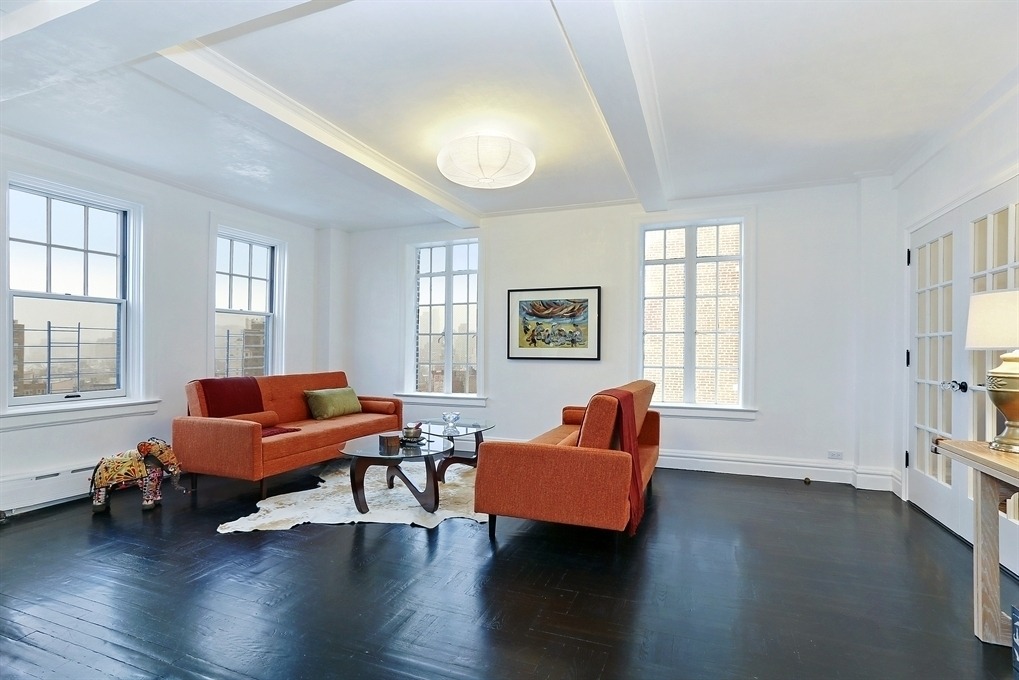
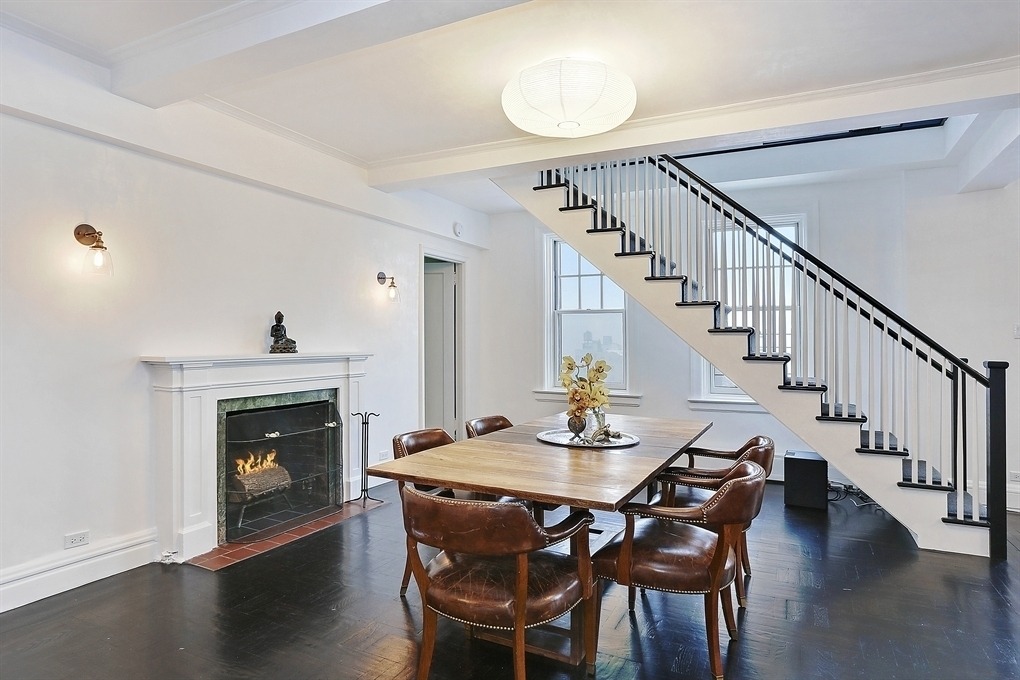
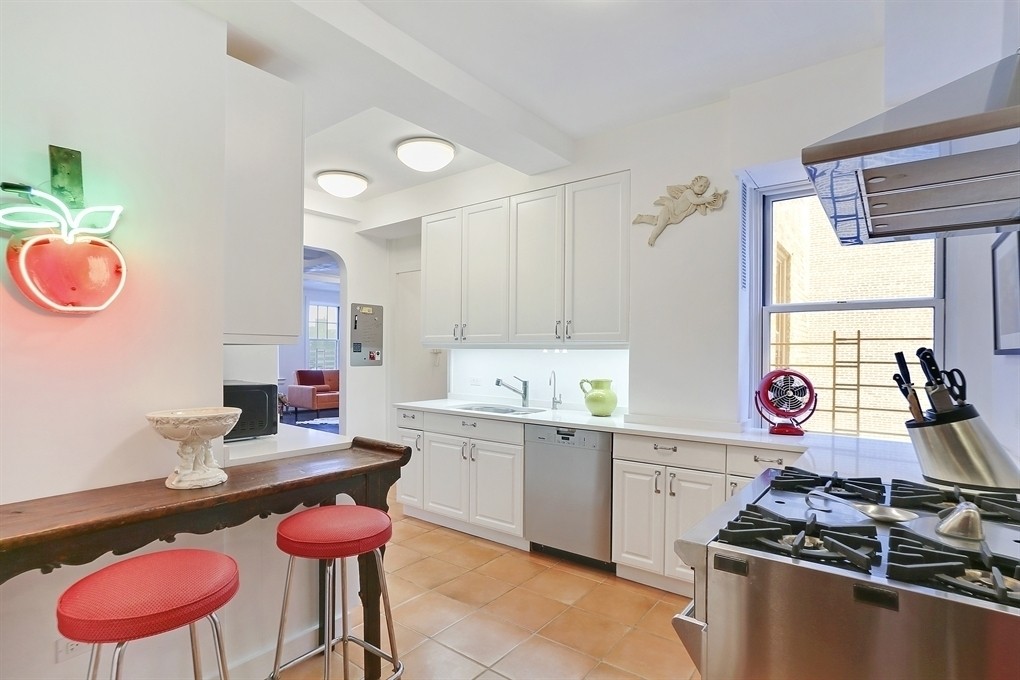

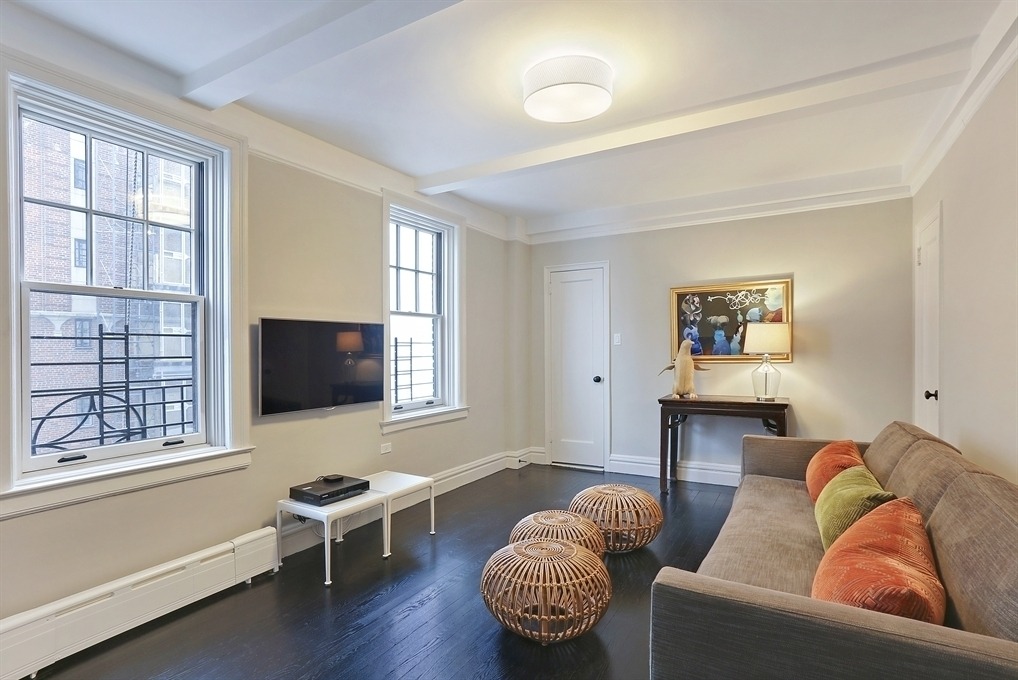
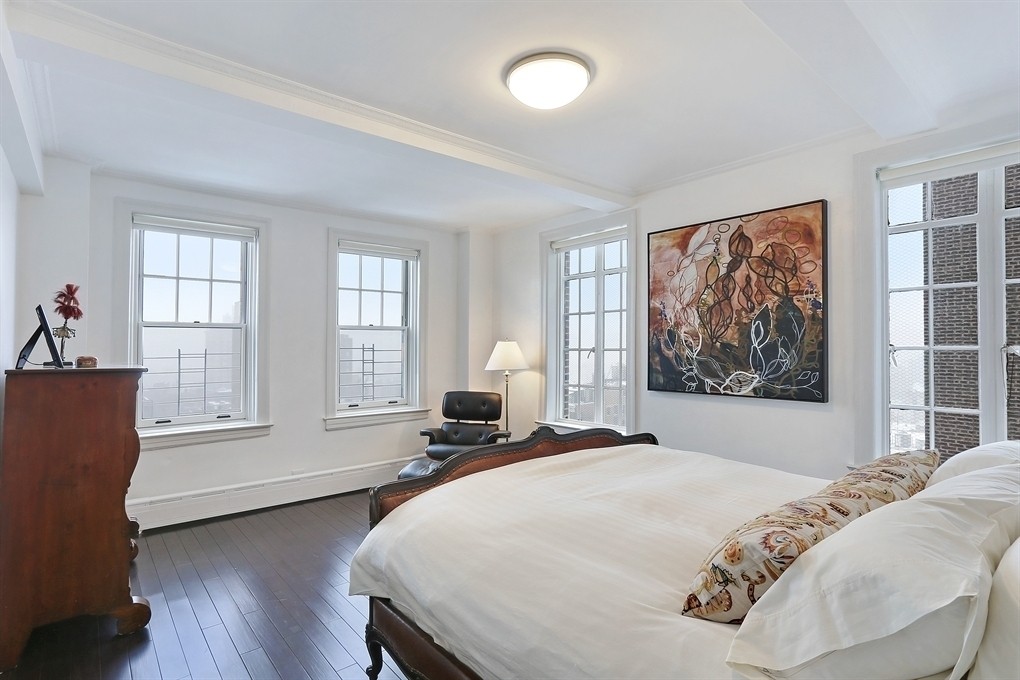
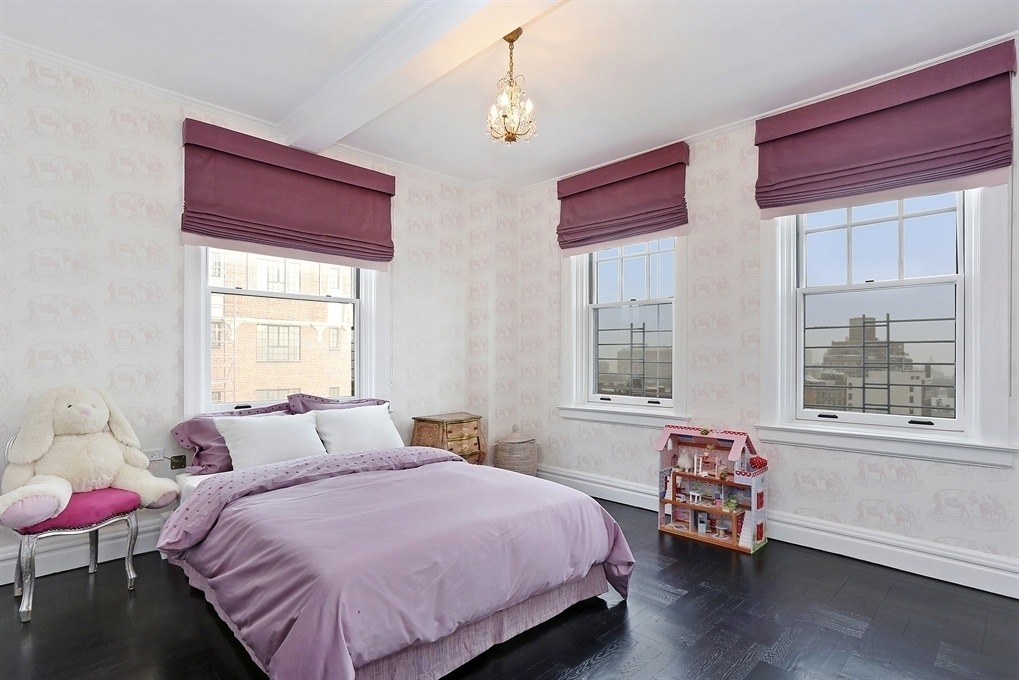
500 Square Inches - NYC’s Smallest Piece of Private Land
If you’ve ever walked by the busy intersection of 7th Avenue South and Christopher Street, you’ve likely seen people snapping photos of the iconic corner-facing Village Cigars, but what you probably didn’t realize is that many of these eager photographers were standing on top of New York City’s smallest piece of private land.
The Hess Triangle sits in the sidewalk at the southwest corner of thisGreenwich Village crossing, a small concrete slab with an imbedded mosaic that reads “Property of the Hess Estate Which Has Never Been Dedicated For Public Purposes.”
Seventh Avenue was laid out as part of the Commissioner’s Plan of 1811, but terminated at Eleventh Street. Starting in 1910, the avenue was extended southward to connect with Varick Street in order to accommodate the construction of the IRT Broadway-Seventh Avenue subway line and link the Village with Tribeca. Over 300 buildings were demolished under Eminent Domain.
One of the razed buildings, a five-story apartment building called the Voorhis, belonged to David Hess. He fought the city in hopes of saving his building, but by 1914 all that remained of his property was a small triangle of sidewalk. The city assumed Hess would donate the tiny tract to the public sidewalk, but they were wrong. He took the city to court and was allowed to retain ownership of his prized triangle.
Village Cigars courtesy of wallyg via photopin cc
On July 27, 1922, Hess had his infamous mosaic message installed in his 500 square inches of land. In 1938, he sold the triangle to Village Cigars for $1,000, and the store has left it intact, a permanent reminder of city history and the resiliency (and stubbornness!) of New Yorkers.
Rupert Murdoch Sells West Village Townhouse For $27.5M
Last August 6sqft reported that News Corp. head and Fox News founder Rupert Murdoch had put his West Village townhouse–the one he’d boughtjust five months prior for $25 million–on the market. Now, just five months after listing the 25-foot-wide, four-story brick home for $28.9M, the house has found a buyer, the New York Observer reports. Whomever is behind the entity known as West 11th Street, LLC has purchased the 6,500-square-foot Greek Revival manse for $27.5 million. The deal represents a $2.5M profit for Murdoch (and we all know how much he needs a few more million).
The grand historic townhouse at 278 West 11th Street has definitely been an easier sell, even for eight figures, than a $72 million triplex trophy pad at Flatiron skyscraper One Madison; the media mogul’s 6,850-square-foot penthouse in that high-profile building has remained unsold since Murdoch listed it in April of 2015 (even with Tom Brady and Gisele Bundchen as neighbors). What–besides the ridiculous price difference and 350 square feet–makes a West Village townhouse so much easier to sell? In addition to location, the house–thoroughly renovated when Murdoch bought it–is gorgeous inside and out, starting with the three-level landscaped patio.
The home’s previous owner, who bought the property for $8.2 million in 2011, restored the former purple bed-and-breakfast to its original single-family mansion glory, restored the home’s façade, and modernized it by replacing south-facing walls with glass to let in more light and adding a roof deck, elevator, 1,200-bottle wine cellar, smart home technology and a gym.
In addition to the elevator, there’s a grand elliptical staircase for making the kind of entrances you can’t make in a lift.
The roof deck has Empire State Building and One World Trade Center views, limestone pavers and a Spanish cedar pergola.
The billionaire octogenarian recently wed former model (and Mick Jagger’s ex) Jerry Hall (his fourth wife), and even more recently saw Fox News embroiled in a sexual harassment scandal involving co-founder Roger Ailes, so having one less property to worry about might be a good thing.
New Self-Driving Bus in Amsterdam Makes the MTA’s Transit Plan Look Dated
While New York City is patting itself on the back for pushing through a subway design that offers eight more inches of door space and an open-gangway format, over in the Netherlands, folks are celebrating the Future Bus, a self-driving bus created by Mercedes-Benz. Per The Verge, the Future Bus has just completed a 20 kilometer (roughly 12.5 miles) drive that took it from Amsterdam’s Schipol Airport to the town of Haarlem (fun side note: Harlem the nabe takes its name from this municipality) along a route that included a number of tight bends, tunnels, and traffic lights.



See Day and Night Views From 432 Park Ave. at 1,400 Feet in the Air
Earlier today, 6sqft brought you flashy new renderings of the amenity spaces at432 Park Avenue. The reveal came with a link to the official building website, which has a section offering jaw-dropping photos that showcase the views from the 1,396-foot tower, the tallest residential building in the Western Hemisphere. As the site notes, they span from the Hudson River to the East River, from Westchester to Brooklyn, and from Central Park to the Atlantic Ocean.
Looking north
In addition to all five boroughs, 432 Park will offer views of New York state, New Jersey, and Connecticut.
Looking west
As 6sqft previously reported, 432 Park can be seen from 47 miles away at sea level, “roughly the distance from the tower to Beacon, NY, Bridgeport, Connecticut, or Trenton, New Jersey.”
Looking south
Though technically One World Trade Center is taller than 432 Park at 1,776 feet, this includes its 408-foot-tall spire. Therefore, 432 Park’s roof is actually 29 feet higher, and its uppermost penthouse will look upon One WTC’s observation deck. And this penthouse will sit at 1,302 feet above street level, making it the highest apartment in the world.
Looking east
Thirteen major bridges can be seen from the top floors of the tower: George Washington Bridge, TriBoro (RFK) Bridge, Queensboro (Ed Koch) Bridge, Whitestone Bridge, Throggs Neck Bridge, Williamsburg Bridge, Manhattan Bridge, Brooklyn Bridge, Verrazano Bridge, Hell’s Gate Bridge, Bayonne Bridge, Pulaski Skyway, and Tappan Zee Bridge.
There’s also the fun video below, which gives a great idea of how light changes from day to night.
City Gives First Approval for the Lowline, Must Raise $10M Over the Next Year
The world’s first underground park just got one step closer to reality thanks to approvals from the NYC Economic Development Corporation. The Lowline, which will occupy a 40,000-square-foot abandoned trolley terminal below Delancey Street on the Lower East Side, received the thumbs up after an eight-monthbidding process during which no one else submitted a proposal.
City hall granted co-creators James Ramsey and Dan Barasch control of the space provided they can reach a $10 million fundraising goal over the next 12 months, complete a schematic design, and host five to 10 public design sessions and quarterly community engagement meetings.
The decision comes after the success of the Lowline Lab (it’s welcomed 70,000 visitors since opening), a miniature version of the subterranean park that tested its remote skylight system and horticulture, as well as conditional approvals from the local community board. It still needs to make its way through the city’s Uniform Land Use Review Process (ULURP), and as NY Mag points out, it may not be so easy to convince the public that the $60 million project that will require as much as $4 million annually in maintenance is feasible.
Though the city has committed no funds to the project, deputy mayor for housing and economic development Alicia Glen made it clear that public support hasn’t been ruled out. She also very exuberantly expressed her interest: “When they first presented it to me, I thought, That is some crazy, smoking-dope stuff — let’s check it out! We’re very excited about taking interesting technology, and the way the tech ecosystem is converging around cities, to solve civic problems and objectives.”
James Ramsey celebrated the victory: “Every designer dreams of doing civic work that contributes to society and to the profession. Over the last 8 years, we just stuck to what we thought was a great idea that could make our city and our community better. We’re thrilled to move ahead on designing and building a space that people will enjoy for generations to come.”
The Lowline Lab will be open through March, 2017; it’s free and open to the public.
Matt Lauer Unloading Southampton Beach Cottage for $4M

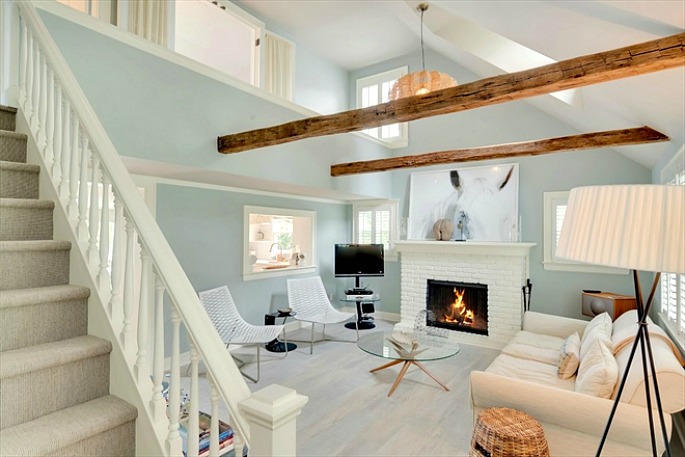
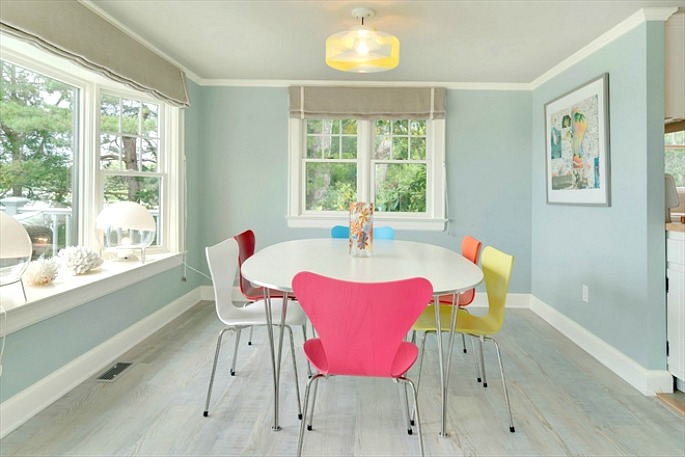


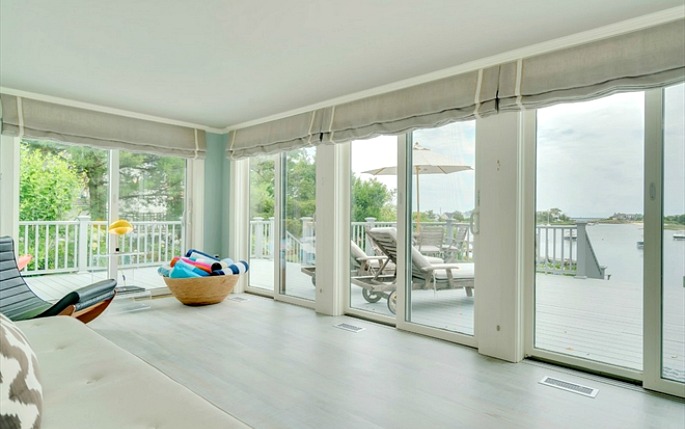

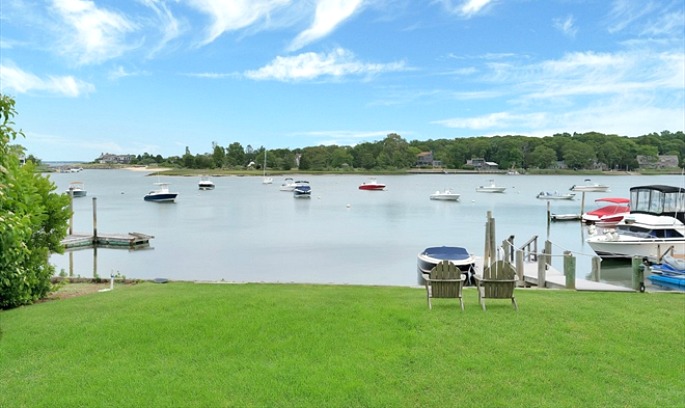
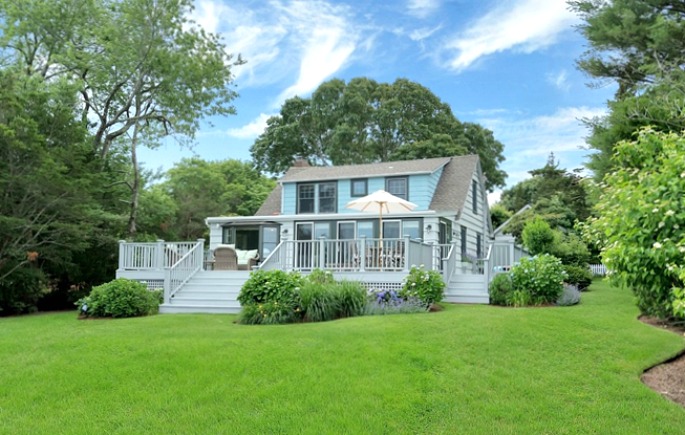

On Monday, 6sqft reported that “Today” anchor Matt Lauer had scooped upRichard Gere‘s Hamptons estate for an impressive $36 million. He’s wasted no time trying to unload his other properties on the island, as the Post reveals today that his Southampton beach cottage has hit the market for $4 million. Located at 67 Scotts Landing Road, the charming waterfront home sits on .75 acres within a community “where houses are generally passed on to the next generation,” according to the listing. This exclusive neighborhood offers tennis courts and access to a bay beach with a pavilion that puts on events.
The cottage is much simpler than Lauer’s new digs; it has three bedrooms and spans just 1,800 square feet. There’s beamed cathedral ceilings and a fireplace in the living room, which has an opening to the country kitchen. Off the kitchen is the dining room that features a lovely bay window.
The enclosed porch has glass doors that lead outside to a deck and down to the yard and 85 feet of bulkhead waterfront.
There also a charming detached garage that’s adjacent to the stone pathway that leads to the front door.
As 6sqft previously noted, “Lauer, who’s notorious for taking a private helicopter back and forth from the city to the Hamptons, also owns a 40-acre farm in Water Mill (where he recently had some beef with his neighbors).”
This Week’s 5 Most Expensive Listings
Here’s our look at the five most expensive residential listings to hit StreetEasy in the past seven days, otherwise known as the crème de la crème of the Manhattan market this week.
30 Park Place #PH82
Address 30 Park Place #PH82
Price $30,000,000
Type/Size Condo: three bedrooms and four-and-a-half bathrooms
This full-floor penthouse in the Robert A.M. Stern designed 30 Park Place is this week’s most expensive listing. Situated on the 82nd floor of the tower, this spread comes with 360 degree views, four private terraces, a library and two walk-in closets.
930 Fifth Avenue 18A–18C
Address 930 Fifth Avenue 18A–18C
Price $19,000,000
Type/Size Co-op
This listing isn’t just one apartment, it’s two. Snap up this combination opportunity and you’ll be the owner of 18A and 18C at 930 Fifth Avenue (where Woody Allen once owned a penthouse). Both units are available individually, but between them will total approximately 5,000 square feet with over 90 feet of frontage on Central Park.
432 Park Avenue #38A
Address 432 Park Avenue #38A
Price $18,350,000
Type/Size Condo: three bedrooms and four-and-a-half bathrooms
This 4,082 square foot spread in New York’s biggest trash can has only been on the market for three days and already it’s in contract. The potential buyers must have been swayed by the library, the private elevator landing and the huge windows with Central Park views.
111 West 67th Street #22EFGH
Address 111 West 67th Street #22EFGH
Price $11,599,000
Type/Size Condo: five bedrooms and five-and-a-half bathrooms
Located at The Park Millennium, this corner apartment spans 3,300 square feet. While it may not be the biggest apartment on this week’s list, with 20 closets it might just have the most storage space. It’s being sold by the anonymous 111 West 67th LLC.
60 Riverside Boulevard #PH4001
Address 60 Riverside Boulevard #PH4001
Price $9,999,000
Type/Size Condo: four bedrooms and four-and-a-half bathrooms
At $9.99 million, this Roman and Williams-designed penthouse is a little cheaper than the homes we usually highlight on this list – but not by much. It’s located on top floor of the Aldyn and has floor-to-ceiling windows and 12-foot-high ceilings. Meanwhile the building itself offers residents access to an athletic club and spa, a playground, a rock climbing wall and a bowling alley.
How NYC’s Supertalls Compare in Height and Girth to Global Towers
As the Skyscraper Museum so aptly writes, “Tall and BIG are not the same thing.”
Echoing 6sqft’s recent post on global supertalls, the infographic above illustrates how when the height of New York’s tallest towers are stacked up against the sky-high constructions abroad (and 1 WTC), our city’s skyscrapers truly are “runts on the world’s stage.” The image also reveals that not only do these towers lack significantly in height, but also in girth. This means what really makes the design of all of New York’s new skyscrapers so unique is not how tall they are, but rather, how slender they are.
“The pencil-thin periscopes — all 50 to 90+ stories — use a development and design strategy of slenderness to pile their city-regulated maximum square feet of floor area (FAR) as high in the sky to as possible to create luxury apartments defined by spectacular views,” says the Skyscraper Museum of this new typology.
“‘Slenderness’” is an engineering definition,” they add. “Structural engineers generally consider skyscrapers with a minimum 1:10 or 1:12 ratio (of the width of the building’s base to its height) to be ‘slender.’ Slenderness is a proportion based on the width of the base to the height of the building.”
In this slender lot, they point out 18 towers in specific that redefine the width versus height ratio, emphasizing again that extreme verticality is not at all representative of total gross floor area: One57, 111 West 57th Street, 432 Park Avenue, 520 Park Avenue, Central Park Tower, 220 Central Park South, 53W53, 100 East 53rd Street, Sky House, 45 East 22nd Street, One Madison, 35 Hudson Yards, 56 Leonard, 30 Park Place,111 Murray Street, 125 Greenwich Street, 50 West Street and 9 DeKalb Avenue.
Average Condo Sale in Manhattan Reaches $2.9M, Setting New Record
For the second quarter in a row, average condo sales prices in Manhattan are breaking records. The first three months of 2016 saw $4.59 billion in aggregate sales, breaking the previous record of $4.57 billion that was set last quarter, according to data from CityRealty. The average sales price topped out at $2.9 million, also significantly higher than last quarter’s $2.5 million. These figures aren’t surprising considering 24 percent of all condo sales during the beginning of this year were at or above $10 million, with new luxury developments like 432 Park Avenue, The Greenwich Lane, and 150 Charles Street accounting for the uptick.
In 1927, NYC Almost Got a 16-Mile Highway Along Building Rooftops
In the early 20th century, engineers and architects were certainly thinking outside the box when it came to city planning here in New York. There was the proposal to fill in the Hudson River for traffic and housing, the idea to create a giant conveyor belt to carry people between Grand Central and Times Square, and the plan tostack the city like a layered cake. Though these ideas sound whacky, they were born from the rise of the automobile and suburbinization. With many Americans moving out of urban centers, planners sought new ways to reimagine the modern city and entice car-loving prospects.
Another such idea is this 1927 one for a 16-mile elevated highway that would have traveled across building rooftops from the Battery all the way to Yonkers. Conceived by engineer John K. Hencken, it required all buildings to be uniform at 12 stories. Within them would have been standard uses — residences, offices, schools, theaters, restaurants — and elevators to take cars from the street to the skyway.
Sure it’s crazy and was never built, but at the time, Hencken’s proposal was “approved by a number of eminent engineers and city planners. They say it is entirely feasible from an engineering standpoint,” according to a Popular Science article in which it was featured. The article continued: “Our artist pictures here an ingenious new plan for solving NYC’s traffic problems by a remarkable system of roof-top boulevards running more than sixteen miles in a straight line through the heart of the city. Bridging of cross streets for free movement of traffic; moving platforms for speedy and convenient service; healthful elevated playgrounds for children; underground railway freight service—these are some of its outstanding features.”
March’s 10 Most-Read Stories
March’s 10 Most-Read Stories
- Skyscraper Proposal Digs Out Central Park and Surrounds It With 1,000-Foot Glass Structure
- Apply for One of Stuyvesant Town’s Affordable Apartments, Starting at $1,200/Month
- Katie Couric Buys $12M Upper East Side Condo
- Apply for 83 Affordable Apartments in Astoria, Starting at $895/Month
- Queens’ New Skyline: A Rundown of the 30 Developments Coming to Long Island City
- Housing Lottery Launches for Greenpoint Landing’s 33 Eagle Street, Rents Start at $494
- My 1,000sqft: Tour a Newly Transplanted Couple’s Bushwick Apartment Filled With Craigslist Finds
- MAP: Where to Find NYC’s Current Affordable Housing Lotteries
- How Horse Poop Inspired the New York City Stoop
- New Views and Renderings of Eliot Spitzer’s ODA-Designed Williamsburg Mega-Development

